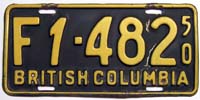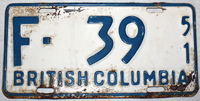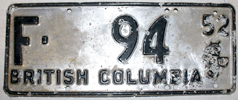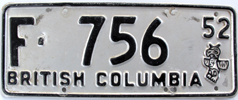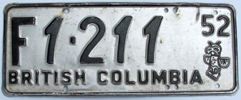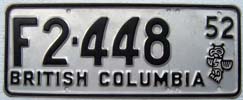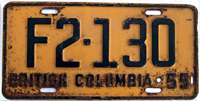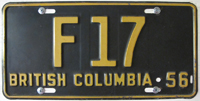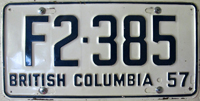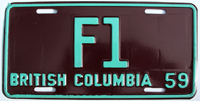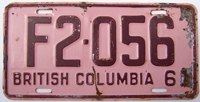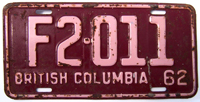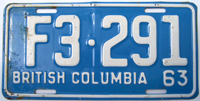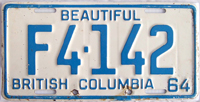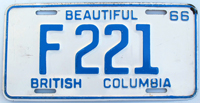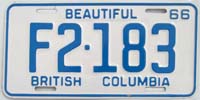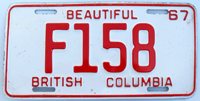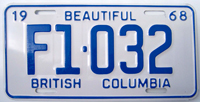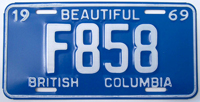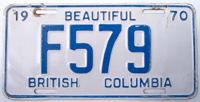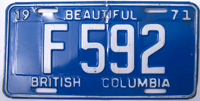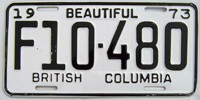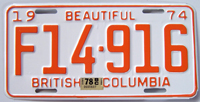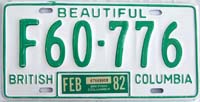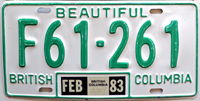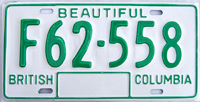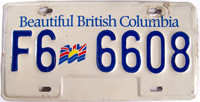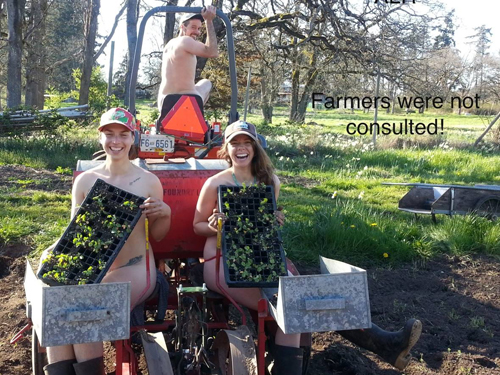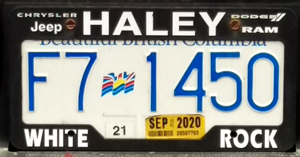|
British Columbia Farm Tractor License Plates |
||||||||||||||||||||||||||||||||||||||||||||||||||||||||||||||||||||||||||||||||||||||||||||||||||||||||||||||||||||||||||||||||||||||||||||||||||||||||||||||||||||||||||||||||||||||||||||||||||||||||||||||||||||||||||||||||||||||||||||||||||||||||||||||||||||||||||||||||||||||||||||||||||||||||||||||||||||||||||||||||||||||||||||||||||||||||||||||||||||
Traditionally,
agriculture has been one of the more important sector's in
British Columbia's economy, behind only forestry and mining.
The nature of agriculture in the province has also been dominated
by the small-scale producer who, during and after WWII, became
increasingly reliant on mechanization - including tractors and trucks. |
Quick Links: |
Farm Tractor | Farm Truck |
The first "F" plates associated with farm tractors commenced in 1948 following an amendment to the Motor Vehicle Act that came into effect on April 3, 1947. Previously, the "F" prefix had been associated with over-run passenger vehicle plates issued out of the MVB's New Westminster office between 1940 and 1947. |
||
It had actually been intended to have "special number plates" available in 1947, however, the legislative change occurred to late in the licence year for such plates to be manufactured at Oakalla. |
||
Issuing officers were thus instructed to issue standard commercial "C" license plates but to account for these by marking "Farm Tractors" on a blank line that appeared under the "Commercial Motor-vehicles" section of the registration application form. |
||
As a result of this decision, the Superintendent of Motor-Vehicles would be reqired in subsequent years to remind officials that Farm Tractors were to be issued "F" plates and not the "ordinary commercial licence plates". |
||
|
| 1948 | ||||||||
1-digit |
 |
|
||||||
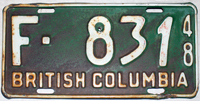 |
||||||||
The 1947 amendments to the Act defined a Farm Tractor as follows: |
|
| (A) | Farm tractors used as implements of husbandry, on a highway immediately adjacent to the owner's farm, for the purposes of proceeding from one place on the farm to another on the same farm, or for the towing implements of husbandry or trailers carrying farm produce or stock, fertilizer, tools, seed, etc., from one place on a farm to another place on the same farm do not require to be license but a person driving the same must not be under the age of fifteen years. |
| (B) | For farm tractors owned by a bona-fide farmer and use for towing a trailer for the purpose of transporting thereon the produce of his own farm to market and of transporting supplies for his own farm from market, a nominal licence fee of $5.00 is required, and persons driving the same must be fully licensed as a driver of a motor-vehicle. |
| (C) | Farm tractors used for other than as stated in (A) and (B) above, must be fully licensed and the driver of same must also be fully licensed. |
| 1949 - 1951 | ||||||||||||
1-digit |
 |
|
||||||||||
1-digit |
2-digit |
|||||||||||
1-digit |
 |
|||||||||||
| 1952: "Totem" Base | |||||||
1-digit |
|
||||||
| 1953-1954 | ||||||||||
1-digit |
|
|||||||||
2-digit |
3-digit |
|||||||||
| 1955-1963 | ||||||||||||||||||||||||
1-digit |
2-digit |
 |
|
|||||||||||||||||||||
1-digit |
 |
|||||||||||||||||||||||
1-digit |
2-digit |
|||||||||||||||||||||||
1-digit |
2-digit |
3-digit |
||||||||||||||||||||||
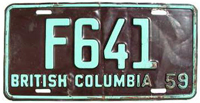 |
||||||||||||||||||||||||
1-digit |
2-digit |
3-digit |
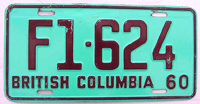 |
|||||||||||||||||||||
1-digit |
2-digit |
 |
||||||||||||||||||||||
1-digit |
2-digit |
3-digit |
||||||||||||||||||||||
1-digit |
 |
3-digit |
||||||||||||||||||||||
.jpg) |
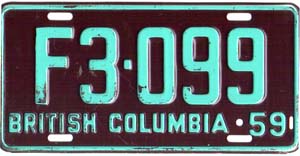 |
.jpg) |
In one of those quirks of the manufacturing process, a small bloc of 1959 plates were produced with the passenger base that had been pre-stamped with two extra slot holes in case the need for renewal tabs arose (which it never did). The middle plate (No. F3-099) shows these extra holes at the bottom right-hand corner. |
||
In 1961, the province created a new type of plate for Farm Trucks utilising an 'A' prefix. Henceforward, the 'F' prefix would be associated solely with Farm Tractors: |
.jpg) Farm Tractor license plate |
.jpg) Farm Truck license plate |
To visit the page related to "Farm Truck" plates, Click here. |
Following the introduction of the Farm Truck plate type, a slow but steady decline in the number of Farm Tractor plates being produced can be seen in the issuing statistics - with a high of 6,700 plates being manufactured in 1964 to a low 3,200 plates in 1973 (the last year for which an annual plate was issued. |
| 1964-1971: "Beautiful" Slogan | ||||||||||||||||||||||
1-digit |
2-digit |
3-digit |
|
|||||||||||||||||||
1-digit |
2-digit |
3-digit |
||||||||||||||||||||
1-digit |
2-digit |
|||||||||||||||||||||
1-digit |
2-digit |
|||||||||||||||||||||
1-digit |
2-digit |
3-digit |
||||||||||||||||||||
1-digit |
2-digit |
4-digit |
||||||||||||||||||||
1-digit |
2-digit |
4-digit |
||||||||||||||||||||
1-digit |
2-digit |
4-digit |
||||||||||||||||||||
| 1972-1973 | ||||||||||
 |
11,000 bloc |
12,000 bloc |
13,000 bloc |
|
||||||
11,000 bloc |
12,000 bloc |
13,000 bloc |
||||||||
| 1974 Base: (1974-78) | ||||||||
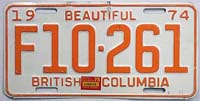 |
12,000 bloc |
 |
|
|||||
| 1975 Base: (1975-78) | ||||||||
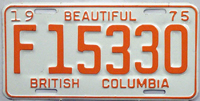 |
|
|||||||
With the 1974 and 1975 bases being able to be renewed by registration decal in 1976, 1977 & 1978, the issuance of plates with the 1976 date stamp likely only occurred for new vehicle registrations and only when 1974 or 1975 stamped bases were no longer available This appears to have been a rare occurence as there are very few of the 1976 bases known to exist, and none which appear to have actually been used on a vehicle (i.e. known examples are new-old stock). In 2024, the first known 1976 dates bases finally re-emerged when a block of 12 sets numbered between F00-080 and F00-091 came to light (and helped fill a lot of collector's holes in their 'F' series runs!). |
| 1976 Base: (1976-78) | ||||||||
 |
|
|||||||
Despite 6,000 plates being manufactured for the 1979 issuance, few of these were issued, making the plate rather difficult to come by. |
| 1979-1986 | ||||||||
|
||||||||
 |
||||||||
 |
||||||||
When the Flag base was introduced in 1985, the numbering of the Farm Tractor serial continued where the 1979 base had left off (i.e. at F66-000). Next to the Manufacturer base, the Farm Tractor plate is one of the rarest and hardest to find plate types on the road with the only confirmation of their continued existence coming from the semi-regular Licence Plate Identification Guide put out by ICBC (which still lists this as a valid plate type with an Allocation Code number of RS007). |
| 1986 - present: Flag Graphic | ||||||||
 |
|
|||||||
One of the reasons the 'F' plates are so uncommon may reside within the requirements of the Motor Vehicle Act. Specifically, Section 8 (Licences for farm tractors) of the Act states that ICBC may issue a licence and number plates for a farm tractor owned by a farmer if the tractor is used for: |
||||
|
||||
Living in an agricultural area of the province, we here at BCpl8s.ca know of no farmers who are properly licenced when driving their tractors on the road. |
Quick Links: |
Farm Tractor | Farm Truck |
|
© Copyright Christopher John
Garrish. All rights reserved.

.jpg)





